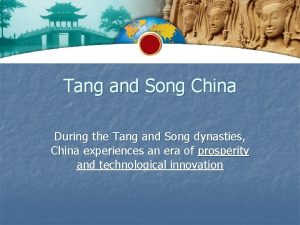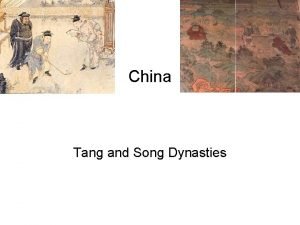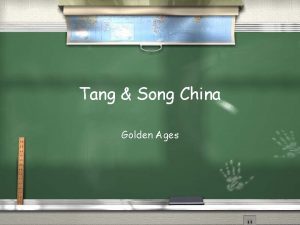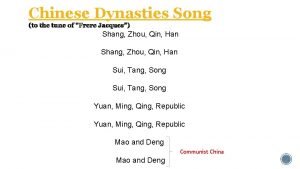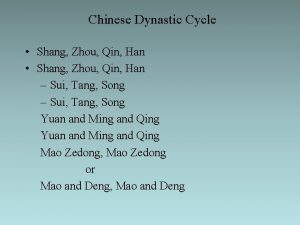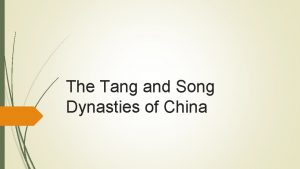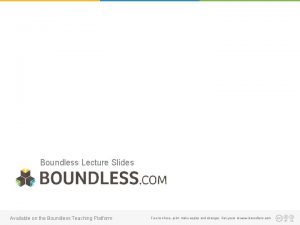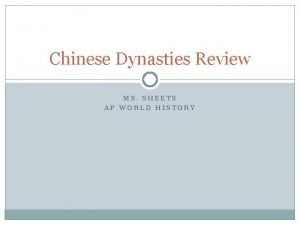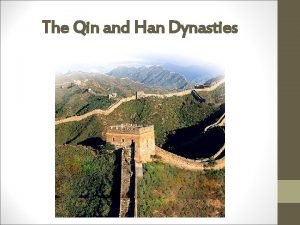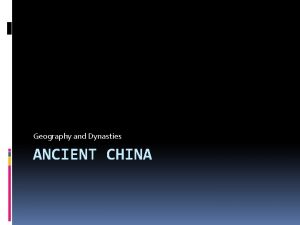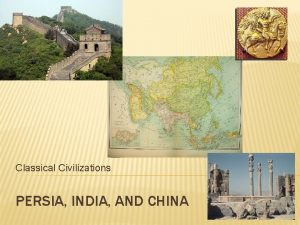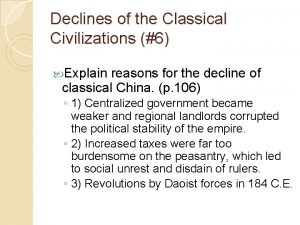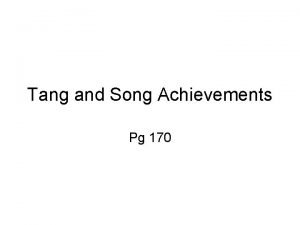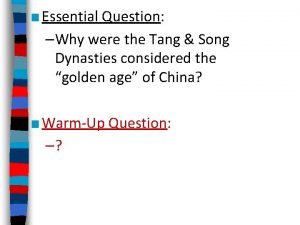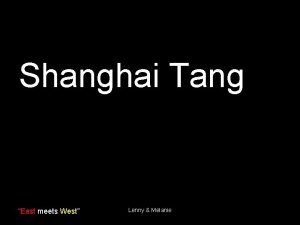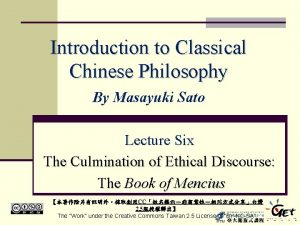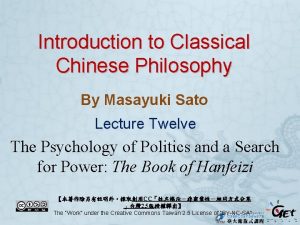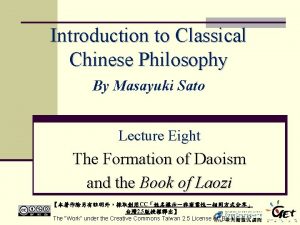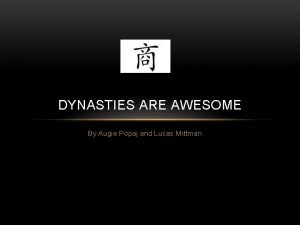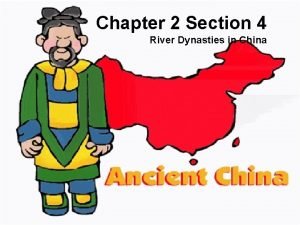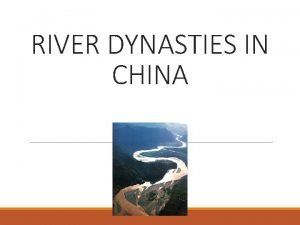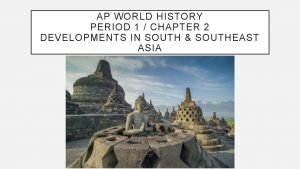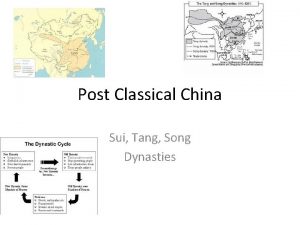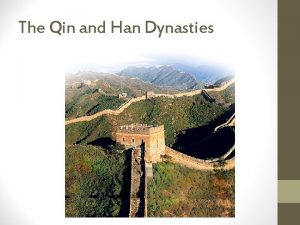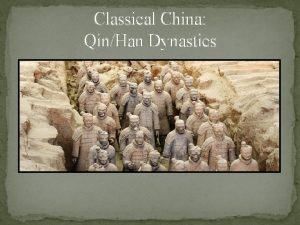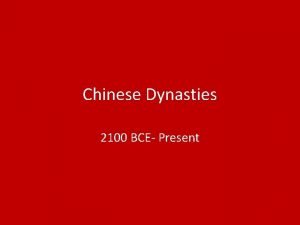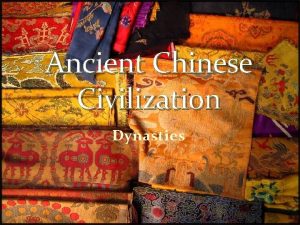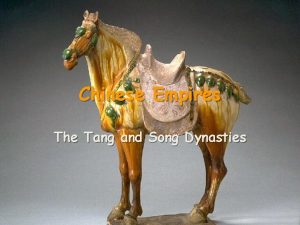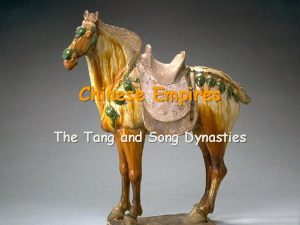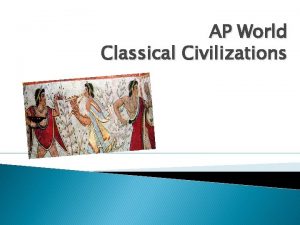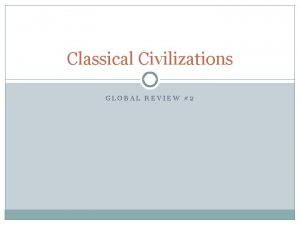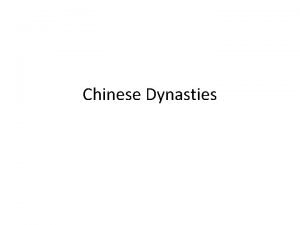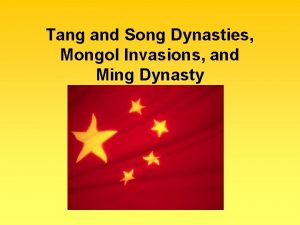Chinese Classical Civilizations The Han Tang Song Dynasties







































- Slides: 39

Chinese Classical Civilizations The Han, Tang & Song Dynasties

HAN Time Period 206 BCE 220 CE (414 years) Classical era Rebelled against Qin Dynasty • • • Culture & Achievements Cause of decline Adopted Confucianism Meritocracy – civil service exam Extended Great Wall West Iron plow, wheelbarrow, horse harness Water wheel = hydroelectric power Repeating crossbow w auto reload PAPER Seismograph: measures earthquakes Start the Silk Road: trade route linked China to Rome Silk making process kept secret Minted coins Corrupt gov’t; local warlords challenge; high taxes; low quality army; invasions by Xiongnu

TANG Time Period 618 -907 CE Militaristic takeover by Li Yuan Culture & Achievements Cause of decline Tea, salt & alcohol were gov’t monopolies Trade along silk road; Islam = CD CD of Chinese culture to Korea & Japan Maritime (Sea) trade with Egypt & Axum Thousands of poems Buddhism supported greatly Invented gunpowder, ceramic porcelain, water clock, woodblock printing, agriculture, medicine: small pox vaccine, a test for diabetes & treated goiters with animal thyroid • Empress Wu: Only female ruler of China Weak leadership; Song takeover • •

Time Period SONG Culture & Achievements • Neo-Confucianism: blends spiritual aspects of Buddhism & Taoism • Class of scholar-gentry • Foot binding Fall of • Permanent standing Navy: Junks Tang • Stern mounted rudder: raised/lowered led to mechanically for different water depths rise of • Magnetic compass Song • Moveable type & printing cost decreased, under more people became literate Taizu • Paper currency (coins too heavy) Smaller • Coal to power furnaces empire • Windmills: to grind grain, to blow air on furnaces & pump water for irrigation • Gunpowder used for weapons: bombs, grenades, flame throwers & hand cannons 9601279 CE Cause of decline Weak military Attacked by foreigners: Jin 1125 & Mongols defeat the Song in 1279

The Han Dynasty lasted over 400 years from 206 B. C. to 220 A. D.

Technology developed under the Han Paper Collar harness Plow Wheelbarrow Waterwheel • Invented in 105 CE • Books became inexpensive to produce; expanded education • Bureaucracy grew and became more efficient • Horses could carry heavier loads • Best harness available at the time worldwide • The Chinese made one with two blades • Much more efficient • Invented independently (Greeks had invented as well) • Central wheel and axle let Chinese wheelbarrows carry very heavy weights • Used to power things such as the bellows for smelting iron

First seismograph

Seismograph Today

Papermaking £ The Han probably made paper for the first time in 100 B. C. £ The emperor found out about paper about 200 years later in 100 A. D.

Paper/book making



Han Art £ The Han also developed the arts. £ Landscape and portrait paintings were advanced. £ Han authors wrote many essays and plays. £ Han authors also wrote history, which is why we know about them.

Han Religions £The Han made Confucianism the official religion of China. £Han rulers also supported Daoism which teaches the key to happiness is accepting life as it is and balancing chi.

Chinese Trade £ The Chinese product most in demand by other people was silk. £ Traders traveled across China to the Middle East with silk.

Map of the Silk Road

The Silk Road £ The Chinese used the Silk Road to export their silk. £ Export means that they sent their goods to other lands to be sold. £ The Chinese also imported what they needed from other countries. £ Import means goods that are brought in. £ The Chinese made profits, or money gained, from their exporting on the Silk Road. £ They returned with lumber, horses, and other products the Chinese people needed.

£ For hundreds of years China had been isolated by its geography; the silk route brought change £ This trade expanded and created an exchange of goods and ideas between Chinese culture and Roman culture = Cultural diffusion!

Buddha statue in central China

Mosque in southern China

Unification of the Han Empire Colonization Assimilation • Farmers sent to settle new areas • Settlers were encouraged to marry locals • Established Confucian schools in colonized areas • Chinese became the common written language

Roles of Women under the Han Traditional Roles Women with Power • Confucianism limited women to the home and to subservience to men (fathers, husbands, sons) • Some women wielded political power because of court alliances • e. g. , Empress Lu • Women worked hard for their families with little reward • Nuns • Educated • Lived apart from families • Medicine practitioners • Shop managers • Writers Paradox? • Ban Zhao • Helped finish her father’s History of the Former Han Dynasty • Wrote Lessons for Women • Urged women to obey the Confucian social order • Also encouraged women to be industrious • Went against convention by writing professionally

The Sui Dynasty £ After Han before the Tang £Built the Grand Canal ¤Connected northern and southern China ¥Increased trade ¥Allowed food from farms in the south to be sent to cities in the north ¤Forced millions of peasants to work on canal ¥Many workers died ¥Forced labor on public works projects angered peasants


Tang Golden Age of Art £ Great poetry: ¤Li Bo and Du Fu

Tang Golden Age of Art £ Three-color ware was one of the greatest contributions of the Tang Dynasty £ Many figurines, predominantly horses and camels, were produced.


£Most of these pieces have been found in the more affluent tombs of the Tang period

£ The Tang Dynasty World View: / Look west along the Silk Road / The Song Dynasty World View: / looks east towards the sea

Tang & Song Dynasties Compared Tang Only Expanded the empire, had a female ruler, adopted Buddhism Both Prospered through trade, improved agriculture, created great art and literature Song Only Ruled smaller empire, developed into great sea power, created paper money and movable type


Science and Technology £ Mathematics flourished £ Adopted the use of algebra and the concept of zero £ Invented movable type

Tang & Song Social Order £Established a strict social order ¤Gentry ¥Wealthy landowners ¥Some become civil servants ¤Peasants ¥farmers ¤Merchants

Song agriculture £ imported fast-ripening rice from Vietnam £ allowed two crops each season instead of one £ fueled population increase

Women Under the Song £ Women were considered inferior to men £ Foot binding: ¤Goal was to create small feet (“lotus”) by restricting the growth of the foot ¥ 3 -4 inches long ¥Done between ages 3 -11




 China song menu
China song menu Tang vs song dynasty venn diagram
Tang vs song dynasty venn diagram Sui tang and song dynasties
Sui tang and song dynasties Tang and song dynasty achievements
Tang and song dynasty achievements Why were the tang and song dynasties golden ages
Why were the tang and song dynasties golden ages Sui tang song
Sui tang song 618 song
618 song Sui tang and song dynasties
Sui tang and song dynasties Golden age of tang and song dynasties
Golden age of tang and song dynasties Shang zhou qin han
Shang zhou qin han Shang zhou qin and han dynasties
Shang zhou qin and han dynasties How did the sui and tang dynasties reunite china
How did the sui and tang dynasties reunite china Empress wu accomplishments
Empress wu accomplishments Chinese dynasties
Chinese dynasties Chinese dynasties
Chinese dynasties Ap world history chinese dynasties
Ap world history chinese dynasties Four chinese dynasties
Four chinese dynasties Chinese dynasty acrostic poem
Chinese dynasty acrostic poem Chinese dynastys
Chinese dynastys What is it
What is it What caused the decline of classical civilizations
What caused the decline of classical civilizations Sự nuôi và dạy con của hổ
Sự nuôi và dạy con của hổ Khi nào hổ con có thể sống độc lập
Khi nào hổ con có thể sống độc lập Hanfu definition
Hanfu definition Song dynasty achievements
Song dynasty achievements Chapter 12 section 1 tang and song china
Chapter 12 section 1 tang and song china The tang and song eras were a golden age of
The tang and song eras were a golden age of Shanghai tang song
Shanghai tang song Sui tang song
Sui tang song Ruler of the land 618
Ruler of the land 618 Spice t chart
Spice t chart Primary 2 malay worksheets
Primary 2 malay worksheets Introduction to classical chinese philosophy
Introduction to classical chinese philosophy Introduction to classical chinese philosophy
Introduction to classical chinese philosophy Introduction to classical chinese philosophy
Introduction to classical chinese philosophy Awesome chinese song
Awesome chinese song Song dynasty social structure
Song dynasty social structure River dynasties in china
River dynasties in china Dynasties of delhi sultanate
Dynasties of delhi sultanate Bhakti movement definition ap world history
Bhakti movement definition ap world history
